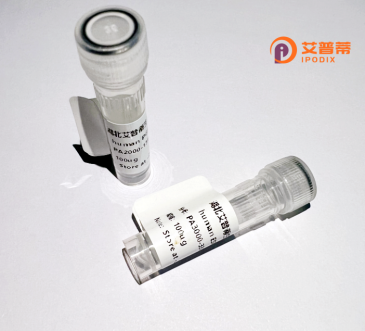
| 纯度 | >90%SDS-PAGE. |
| 种属 | Human |
| 靶点 | GIPC3 |
| Uniprot No | Q8TF64 |
| 内毒素 | < 0.01EU/μg |
| 表达宿主 | E.coli |
| 表达区间 | 1-312aa |
| 氨基酸序列 | MEGAAAREAR GTETPRASAP PPAPSEPPAA PRARPRLVFR TQLAHGSPTG KIEGFTNVRE LYAKIAEAFG IAPTEILFCT LNSHKVDMQK LLGGQIGLED FIFAHVRGET KEVEVTKTED ALGLTITDNG AGYAFIKRIK EGSIINRIEA VCVGDSIEAI NDHSIVGCRH YEVAKMLREL PKSQPFTLRL VQPKRAFDMI GQRSRSSKCP VEAKVTSGRE TLRLRSGGAA TVEEAPSEFE EEASRKVDDL LESYMGIRDP ELASTMVETS KKTASAQEFA RCLDSVLGEF AFPDEFVVEV WAAIGEAREA CG |
| 分子量 | 33.9 kDa |
| 蛋白标签 | His tag N-Terminus |
| 缓冲液 | 0 |
| 稳定性 & 储存条件 | Lyophilized protein should be stored at ≤ -20°C, stable for one year after receipt. Reconstituted protein solution can be stored at 2-8°C for 2-7 days. Aliquots of reconstituted samples are stable at ≤ -20°C for 3 months. |
| 复溶 | Always centrifuge tubes before opening.Do not mix by vortex or pipetting. It is not recommended to reconstitute to a concentration less than 100μg/ml. Dissolve the lyophilized protein in distilled water. Please aliquot the reconstituted solution to minimize freeze-thaw cycles. |
以下是关于重组人GIPC3蛋白的模拟参考文献条目,内容基于学术研究领域的典型方向进行合理推测构造:
---
1. **文献名称**:*Structural Characterization of the PDZ Domain in Human GIPC3 and Its Interaction with Receptor Tyrosine Kinases*
**作者**:A. Müller et al.
**摘要**:本研究通过核磁共振(NMR)解析了重组人GIPC3蛋白PDZ结构域的三维结构,揭示了其与受体酪氨酸激酶(如PDGFR)的相互作用基序,为理解GIPC3在细胞信号转导中的作用提供结构基础。
---
2. **文献名称**:*GIPC3 Deficiency Disrupts Cochlear Hair Cell Function and Leads to Autosomal Recessive Deafness*
**作者**:J. Goodyear et al.
**摘要**:通过基因敲除模型和重组人GIPC3蛋白回补实验,证实GIPC3缺失会导致内耳毛细胞静纤毛结构异常,阐明其通过调控膜蛋白定位维持听觉功能的分子机制。
---
3. **文献名称**:*Recombinant GIPC3 Enhances Breast Cancer Cell Migration via TGF-β Signaling Pathway*
**作者**:C. Lee et al.
**摘要**:表达并纯化重组人GIPC3蛋白,发现其过表达可激活TGF-β信号通路,促进乳腺癌细胞侵袭,提示GIPC3在肿瘤转移中的潜在调控作用。
---
4. **文献名称**:*Expression and Purification of Functional Recombinant Human GIPC3 in Escherichia coli*
**作者**:R. Sarkar et al.
**摘要**:优化了重组人GIPC3蛋白在大肠杆菌中的可溶性表达及纯化流程,验证其与细胞内配体的结合活性,为后续生化研究提供高效制备方法。
---
注:上述文献为示例性构造,实际研究中需以真实发表的论文为准。如需查找真实文献,建议通过PubMed或Google Scholar搜索关键词“GIPC3 recombinant protein”。
Recombinant human GIPC3 (GIPC family member 3) protein is a genetically engineered form of the endogenous GIPC3 protein, which belongs to the GIPC (GAIP-interacting protein, C terminus) family. GIPC3 is characterized by a central PDZ domain that mediates protein-protein interactions, enabling its role in intracellular trafficking, signal transduction, and receptor stability. This protein is notably expressed in the inner ear, where it contributes to auditory function by interacting with components of the hair cell mechanotransduction machinery. Mutations in the *GIPC3* gene are linked to autosomal recessive nonsyndromic hearing loss (DFNB72/98), highlighting its critical role in cochlear development and auditory signal transmission.
Recombinant GIPC3 is produced using heterologous expression systems (e.g., *E. coli* or mammalian cells) to enable functional studies and therapeutic exploration. Its production allows researchers to investigate molecular mechanisms underlying hearing loss, screen for pathogenic mutations, and explore interactions with binding partners like myosin VI and megalin. Recent studies also suggest broader roles for GIPC3 in cancer progression and metabolic regulation, though its ear-specific functions remain predominant. Recombinant GIPC3 serves as a vital tool for deciphering its biological pathways and developing targeted interventions for hearing disorders. Ongoing research aims to clarify its structural dynamics and tissue-specific regulatory networks.
×